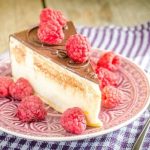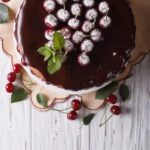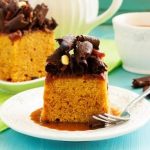Creating a stunning stacked cake is a sure way to impress your guests at any special occasion. Learning how to frost and decorate a stacked cake can elevate your baking skills and presentation to the next level. Stacked cakes are not just delicious treats; they are also visually appealing showstoppers that can make any event memorable.
The art of stacking cakes involves choosing the right cake layers, leveling them, and creating beautiful designs with frosting and decorations. When done correctly, a stacked cake can be a centerpiece that steals the spotlight. Whether it’s for a wedding, birthday, or any celebration, a well-executed stacked cake can leave a lasting impression on your guests.
In this article, we will guide you through the process of frosting and decorating a stacked cake like a pro. From selecting the perfect cake layers to mastering different frosting techniques and adding decorative elements, we will help you create a masterpiece that not only tastes delicious but also looks stunning. Let’s dive into the world of stacked cakes and unleash your creativity in the kitchen.
Choosing the Right Cake Layers for Stacking
When it comes to creating a stacked cake, choosing the right cake layers is key to achieving a stable and visually appealing result. For stacked cakes, it is essential to choose dense and sturdy cake layers that can support the weight of multiple tiers without collapsing. Avoid using light and fluffy cakes that might not hold up well when stacked on top of each other.
One popular choice for stacked cakes is a classic vanilla or chocolate sponge cake, as they are firm enough to withstand stacking while still being moist and delicious. Alternatively, you can opt for a denser cake like a carrot or red velvet cake, which also work well for stacking due to their sturdy texture.
Tips for Choosing Cake Layers
When selecting cake layers for stacking, consider the flavor profile of your overall design. Choose flavors that complement each other and will work well with the frosting and decorations you have in mind. It’s also important to consider the height of each layer to ensure they are uniform and will stack evenly.
In addition to choosing the right type of cake layers, make sure to bake them in even thicknesses using quality pans to avoid any lopsidedness when stacking. Taking the time to select the proper cake layers will set the foundation for a beautifully finished stacked cake that is both stable and delicious.
Leveling and Stacking the Cake Layers
When it comes to creating a visually appealing stacked cake, leveling and stacking the cake layers correctly is key. Ensuring that each layer is even and secure will not only make the cake look professional but also help in creating a stable structure. Here are some tips on how to properly level and stack your cake layers:
- Leveling: Use a serrated knife or a cake leveler to trim any domed tops off your baked cakes. This will allow for a flat surface on each layer, making it easier to stack.
- Stacking: Begin by placing one layer of cake on your serving platter or cake board. Spread a thin layer of frosting on top of the first layer before placing the next one on top. Repeat this process until all layers are stacked.
- Support: To add stability to your stacked cake, consider using dowels or straws inserted into the center of the cake to support the weight of the layers above.
Properly leveling and stacking your cake layers will set a strong foundation for the rest of your decorating process. It will ensure that your stacked cake looks not only visually appealing but also structurally sound.
Once you have successfully leveled and stacked your cake layers, you can move on to applying a crumb coat for a smooth finish. This step will help seal in any loose crumbs and create a clean base for your final frosting layer. Follow these steps to achieve a flawless finish on your stacked cake:
- Apply a thin layer of frosting all around the exterior of the stacked cake, covering all visible surfaces.
- Chill the crumb-coated cake in the refrigerator for about 30 minutes to allow the frosting to set.
- Once chilled, apply a second, thicker layer of frosting over the crumb coat for a polished look.
By following these steps, you’ll be well on your way to mastering how to frost and decorate a beautifully stacked cake that will surely impress any guests at your next event.
Creating a Crumb Coat for a Smooth Finish
Once the crumb coat is applied, place the cake in the refrigerator for about 30 minutes to allow the frosting to set. This will make it easier to apply the final layer of frosting without disturbing the crumbs. After chilling, add another thicker layer of your desired frosting over the crumb coat. Use an offset spatula to spread the frosting evenly across the cake, covering any imperfections and creating a smooth surface.
One tip for creating a crumb coat is to use a turntable when frosting the cake. This allows you to rotate the cake as you frost, making it easier to achieve an even coating. Additionally, using a bench scraper can help create sharp edges and smooth sides on your stacked cake. With these techniques, you can ensure that your crumb coat sets the foundation for a beautifully frosted and decorated stacked cake masterpiece.
| Crumb Coat Technique | Benefits |
|---|---|
| Apply thin layer of frosting all over cake | Seals in crumbs for cleaner finish |
| Chill in refrigerator before final layer | Makes it easier to apply final frosting layer |
| Use turntable and bench scraper | Achieves even coating and sharp edges |
Different Frosting Techniques for Stacked Cakes
Frosting a stacked cake can be a fun and creative process that adds the final touch to your showstopping dessert. One popular technique for frosting a stacked cake is the “naked cake” style, where just a thin layer of frosting is applied around the sides of the cake, allowing the layers to peek through slightly. This rustic look is great for a more casual or bohemian-themed event and gives a homemade feel to your creation.
If you prefer a more traditional frosted finish, you can opt for a smooth buttercream coating. Start by applying a crumb coat as mentioned in a previous section to seal in the crumbs and create a smooth base. Once chilled, add another layer of frosting and use an icing smoother or offset spatula to achieve an even finish. This technique is versatile and allows you to play with different colors and textures for your stacked cake.
For those looking to take their frosting skills to the next level, consider experimenting with textured finishes such as ruffles, rosettes, or basketweave designs. These intricate techniques require some practice but can elevate the look of your stacked cake and impress your guests. Remember to have fun and let your creativity shine through as you explore different frosting techniques for your masterpiece.
| Frosting Techniques | Description |
|---|---|
| Naked Cake | Thin layer of frosting allowing layers to peek through |
| Smooth Buttercream Coating | Create an even finish with versatile options for colors and textures |
| Textured Finishes | Ruffles, rosettes, or basketweave designs that require practice but elevate the look of the cake |
Decorating With Piping Designs and Swirls
Choosing the Right Piping Tips
The first step in creating beautiful piping designs and swirls on your stacked cake is choosing the right piping tips. Large round tips are perfect for creating smooth lines and borders, while star-shaped tips can be used for creating rosettes or shell borders. For more intricate designs, consider using specialty tips like leaf tips or petal tips. Experiment with different sizes and shapes to find the perfect tip for your desired design.
Techniques for Piping Designs
To create stunning piping designs on your stacked cake, start by practicing on a flat surface to get a feel for the pressure needed to create consistent lines. When you’re ready to pipe onto the cake, hold the piping bag at a 45-degree angle and apply gentle pressure as you guide the tip along the surface of the cake.
Practice different movements like zig-zags, swirls, or writing words with icing to add a personal touch to your creation.
Combining Piping Designs With Swirls
For a truly eye-catching effect, consider combining piping designs with swirls on your stacked cake. Use contrasting colors or complementary shades of frosting to create dimension and visual interest. You can pipe delicate flowers around the edges of each tier, add geometric patterns along the sides, or even write a special message in elegant script across the top layer. Get creative and let your imagination run wild as you decorate your masterpiece.
Adding Decorative Elements Such as Fresh Flowers or Edible Toppers
Before placing fresh flowers on your cake, make sure they are clean and free from any pesticides or chemicals. It’s recommended to use organic flowers that are safe for consumption. To prepare the flowers for decorating the cake, gently remove any excess stems or leaves and trim them to the desired length. When placing fresh flowers on a stacked cake, be mindful of their placement and ensure they are securely attached to the frosting or cake tiers.
In addition to fresh flowers, edible toppers can also add a creative and personalized touch to a stacked cake. Edible toppers come in various forms such as fondant decorations, chocolate shapes, sugar figurines, or customized messages made from icing.
These edible elements can be used to reflect the theme of an event or celebration and add a unique flair to the overall presentation of the cake. When using edible toppers on a stacked cake, consider incorporating them into the design seamlessly by placing them strategically on different tiers or along the sides for a cohesive look.
Tips for Transporting and Storing a Stacked Cake
Stacked cakes serve as the centerpiece of any celebration, making them the perfect showstopper for any event. However, once you have beautifully frosted and decorated your stacked cake, it is important to ensure it reaches its destination in pristine condition. Here are some tips for transporting and storing a stacked cake to ensure all your hard work pays off:
- Choose a sturdy cake board that is larger than the bottom tier of your stacked cake to provide ample support during transportation.
- Secure each tier with dowels or plastic straws inserted into the center of the cake to prevent shifting and keep it stable while on the move.
- Consider investing in a cake box that is tall enough to accommodate the height of your stacked cake, ensuring that it remains protected from any accidental bumps or jostles during transport.
When it comes to storing a stacked cake before serving, proper handling is key to maintaining its freshness and appearance. Here are some additional tips for storing your masterpiece:
- If possible, store the finished cake in a cool, dry place away from direct sunlight and heat sources to prevent any melting or warping of decorations.
- Refrigerate the stacked cake if it contains perishable fillings or frostings, but be sure to allow it to come to room temperature before serving to ensure the best taste and texture.
- Cover the stored cake with a dome lid or plastic wrap to protect it from dust, odors, and potential contamination while maintaining its beautiful presentation until ready for consumption.
By following these tips for transporting and storing a stacked cake, you can confidently showcase your masterpiece at any event without worrying about any mishaps along the way. Make sure all your hard work pays off by ensuring your stacked cake arrives safely and remains fresh until it’s time for everyone to enjoy.
Conclusion
In conclusion, mastering the art of stacking, frosting, and decorating a cake can truly elevate your baking skills to the next level. Stacked cakes are not only visually impressive but also offer an opportunity to showcase your creativity and personal style. By following the steps outlined in this guide on how to frost and decorate a stacked cake, you can create a showstopping masterpiece that will leave your guests in awe.
Remember that choosing the right cake layers, leveling them properly, and applying a crumb coat are essential steps in achieving a smooth finish for your stacked cake. Experiment with different frosting techniques such as buttercream or fondant to add texture and depth to your creation. Don’t be afraid to get creative with piping designs, swirls, and other decorative elements to make your cake truly unique.
Whether you decide to adorn your stacked cake with fresh flowers, edible toppers, or intricate designs, the key is to have fun and let your imagination run wild. And once your masterpiece is complete, be sure to transport and store it carefully to maintain its beauty until the big reveal. So go ahead, unleash your inner baker and showcase your stacked cake masterpiece for all to admire.
Frequently Asked Questions
How Do You Frost and Stack a Cake?
Frosting and stacking a cake requires a few basic steps. Firstly, ensure that the cakes are fully cooled before starting. Then, apply a crumb coat of frosting all over the cake to seal in any loose crumbs.
Once set, add another layer of frosting for the final smooth finish. To stack the cakes, place one layer on a cake board or plate and add a generous amount of frosting on top before adding the next layer. Repeat until all layers are stacked.
How Do You Stack Two Cakes on Top of Each Other?
When stacking two cakes on top of each other, it is crucial to make sure that both cakes are leveled to avoid any lopsidedness. Start by placing one cake on a cake board or plate and apply a generous amount of frosting on top.
Then carefully place the second cake on top and press down gently to secure it in place. Finally, frost the entire stacked cake as desired.
How Do You Fill and Stack a Layered Cake?
Filling and stacking a layered cake involves creating even layers of filling between each cake layer. Begin by leveling each cake layer before adding your desired filling such as buttercream, ganache, fruit compote, or jam. Spread an even layer of filling on top of one layer before placing another evenly-leveled cake on top.
Repeat this process until all layers are stacked with filling in between each one. Finish off by frosting the outside of the layered cake for a beautiful finish.

Welcome to my blog about home and family. This blog is a place where I will share my thoughts, ideas, and experiences related to these important topics. I am a stay-at-home mom with two young children. I hope you enjoy reading it! and may find some helpful tips and ideas that will make your home and family life even better!





